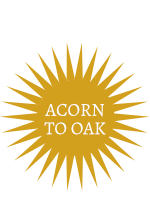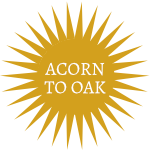
How Should A Child Learn To Read?
A play-based approach to reading leads to better retention and helps the child develop a healthy relationship with reading. According to research by Dr. Karyn Purvis, scientists have discovered that it takes approximately 400 repetitions to create a new synapse in the brain, unless it is done in play, in which case it only takes 10 to 20 repetitions. Reading quality, language-rich text also plays a crucial role in helping a child learn to read by providing numerous cognitive and linguistic benefits that support their overall literacy development. Acorn to Oak has developed a unique way of learning to read which requires no worksheets, no memorization, and no flash cards.
Using the Rhythmic Reading Method, children learn to read using real-world text. Rhythmic Reading teaches phonics in combination with sight words, setting the foundation to fully understand our written language and how it functions. The Rhythmic Reading Method combines the child’s natural curiosity and captures them with engaging text. The child learns to read new words intuitively and is given the opportunity to become a natural reader from the very start of their reading journey.
Phonics and Phenological Awareness
Phonics is a method that teaches the correspondence between sounds and the letters that represent those sounds. According to the National Reading Panel, systematic and explicit phonics instruction improves children’s word recognition, spelling, and reading comprehension skills. Phonological awareness involves the ability to identify and manipulate the sounds of spoken language, such as recognizing rhymes, syllables, and individual sounds (phonemes). Developing strong phonological awareness is a predictor of reading success. The Rhythmic Reading Method teaches phonics through reading games, poetry, and multi-sensory reading activities.
Lily Pad Reading
Draw lily pads on the ground using sidewalk chalk. Write letters inside of the lily pads. Have the child jump from lily pad to lily pad, making the letter sounds as they land on them.
Vocabulary Development
A rich vocabulary is essential for comprehension and overall reading proficiency. Research suggests that children learn vocabulary best through exposure to a wide range of words in meaningful contexts.
The Rhythmic Reading Method teaches reading through language-rich text, such as classic poetry. The child reads the words in bold, and the parent reads the rest. The child and parent take turns reading, in a rhythm.
THE sun descending in the west,
The evening star does shine;
The birds are silent in their nest.
And I must seek for mine.
The moon, like a flower
In the sun’s shade,
With silent delight
Sits and smiles on the night.
William Blake
adapted by Acorn to Oak
Reading Fluency
Fluency refers to the ability to read with speed, accuracy, and expression. Fluent readers comprehend text more easily, which motivates further reading practice. Research supports repeated reading and guided oral reading activities to improve fluency. Providing opportunities for your child to read aloud and receive feedback helps build fluency skills.
Want to learn more about the Rhythmic Reading Method? Try our curriculum for free!







